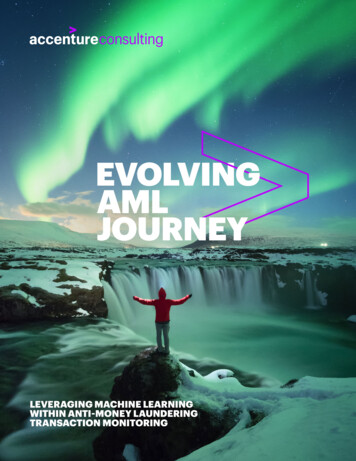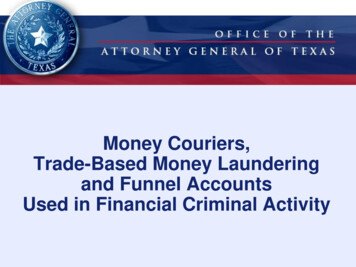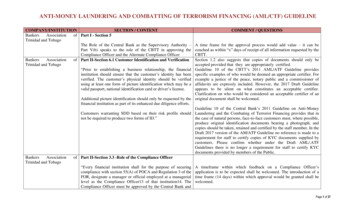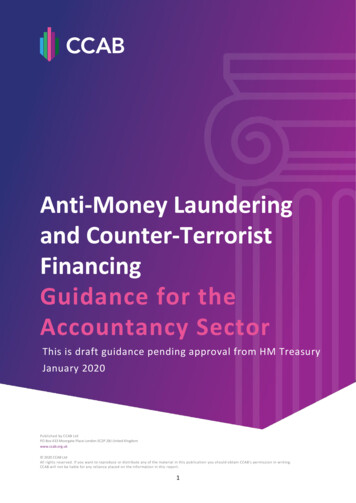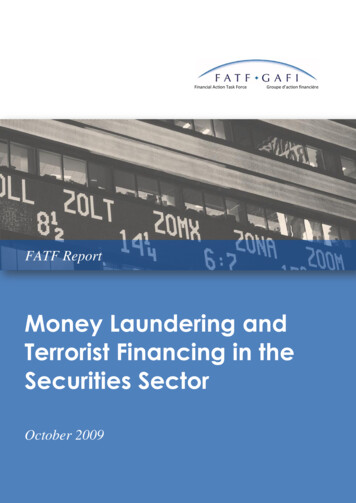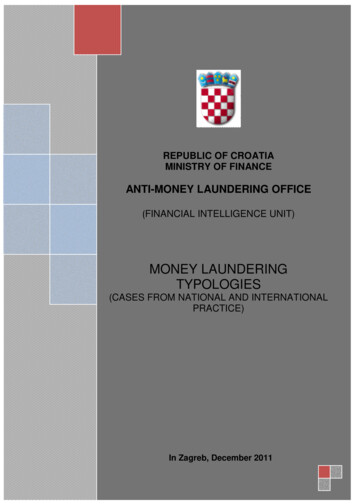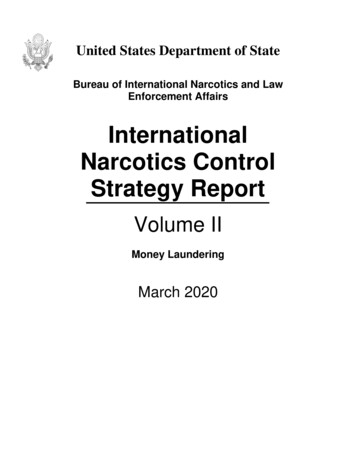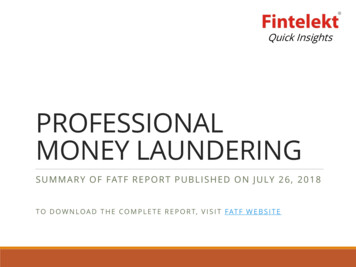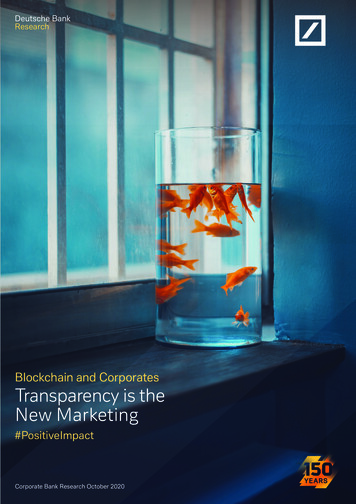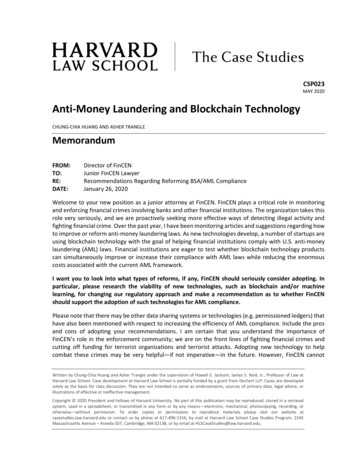
Transcription
CSP023MAY 2020Anti-Money Laundering and Blockchain TechnologyCHUNG-CHIA HUANG AND ASHER TRANGLEMemorandumFROM:TO:RE:DATE:Director of FinCENJunior FinCEN LawyerRecommendations Regarding Reforming BSA/AML ComplianceJanuary 26, 2020Welcome to your new position as a junior attorney at FinCEN. FinCEN plays a critical role in monitoringand enforcing financial crimes involving banks and other financial institutions. The organization takes thisrole very seriously, and we are proactively seeking more effective ways of detecting illegal activity andfighting financial crime. Over the past year, I have been monitoring articles and suggestions regarding howto improve or reform anti-money laundering laws. As new technologies develop, a number of startups areusing blockchain technology with the goal of helping financial institutions comply with U.S. anti-moneylaundering (AML) laws. Financial institutions are eager to test whether blockchain technology productscan simultaneously improve or increase their compliance with AML laws while reducing the enormouscosts associated with the current AML framework.I want you to look into what types of reforms, if any, FinCEN should seriously consider adopting. Inparticular, please research the viability of new technologies, such as blockchain and/or machinelearning, for changing our regulatory approach and make a recommendation as to whether FinCENshould support the adoption of such technologies for AML compliance.Please note that there may be other data sharing systems or technologies (e.g. permissioned ledgers) thathave also been mentioned with respect to increasing the efficiency of AML compliance. Include the prosand cons of adopting your recommendations. I am certain that you understand the importance ofFinCEN’s role in the enforcement community; we are on the front lines of fighting financial crimes andcutting off funding for terrorist organizations and terrorist attacks. Adopting new technology to helpcombat these crimes may be very helpful—if not imperative—in the future. However, FinCEN cannotWritten by Chung-Chia Huang and Asher Trangle under the supervision of Howell E. Jackson, James S. Reid, Jr., Professor of Law atHarvard Law School. Case development at Harvard Law School is partially funded by a grant from Dechert LLP. Cases are developedsolely as the basis for class discussion. They are not intended to serve as endorsements, sources of primary data, legal advice, orillustrations of effective or ineffective management.Copyright 2020 President and Fellows of Harvard University. No part of this publication may be reproduced, stored in a retrievalsystem, used in a spreadsheet, or transmitted in any form or by any means—electronic, mechanical, photocopying, recording, orotherwise—without permission. To order copies or permissions to reproduce materials please visit our website atcasestudies.law.harvard.edu or contact us by phone at 617-496-1316, by mail at Harvard Law School Case Studies Program, 1545Massachusetts Avenue – Areeda 507, Cambridge, MA 02138, or by email at HLSCaseStudies@law.harvard.edu.
ANTI-MONEY LAUNDERING AND BLOCKCHAIN TECHNOLOGYCSP023support the use of new technology by financial institutions if it means less-effective monitoring orenforcement.I would like your recommendation on my desk as soon as possible. I have had our analysts compile thefollowing primer to help bring you up to speed on these issues.Origins of the Bank Secrecy Act and Subsequent LegislationFinCEN is a bureau of the U.S. Department of the Treasury and is tasked with safeguarding the financialsystem from illicit use and combating domestic and international financial crimes, including moneylaundering and terrorist financing. 1 As a feature of its enforcement powers, FinCEN is the designatedadministrator of the Bank Secrecy Act of 1970 (BSA) and the subsequent laws enhancing and amendingthe BSA. 2The goal of the BSA compliance scheme is to encourage financial institutions to help identify the source,volume, and movement of currency flowing through those financial institutions. 3 As initially conceived,the BSA was implemented as a way to fight the drug trade in the 1970s, as drug dealers were using thefinancial system to divert profits from illegal operations to legitimate sources. 4 To combat this moneylaundering, authorities sought to “follow the money” and establish a paper trail of all customertransactions in an effort to make it far more difficult for drug dealers to launder profits. 5 To accomplishthis, the BSA established recordkeeping and reporting requirements like the Consumer Transaction Report(CTR) for all deposits, withdrawals, exchanges, or transfer of funds over 5,000 (since increased to 10,000). 6Since 1970, numerous other laws have been enacted by Congress enhancing and amending the BSA toprovide FinCEN and other regulatory agencies with the most effective tools to detect and prevent moneylaundering and other financial crimes. 7 The Money Laundering Control Act of 1986 (MLCA) directedfinancial institutions to establish and maintain procedures designed to reasonably monitor and ensurecompliance with the reporting and recordkeeping requirements of the BSA while imposing sanctions onfinancial institutions that assisted customers in laundering money. 8 Later, the Annunzio-Wylie Anti-MoneyLaundering Act of 1992 expanded the concept of the CTR and required financial institutions to file reportswhenever they detected suspicious activity. 9 The Annunzio-Wylie Act also granted the U.S. Treasury broadauthority to create AML regulations and demand reports for any violation of law or regulation. 10In the wake of the September 11, 2001 terrorist attacks, Congress passed the Uniting and StrengtheningAmerica by Providing Appropriate Tools Required to Intercept and Obstruct Terrorism Act of 2001 (Patriot12345678910Mission, FINCEN, www.fincen.gov/about/mission [perma.cc/LJX2-ARFE] (last visited Oct. 30, 2016).FinCen, History of Anti-Money Laundering Laws, FINCEN, www.fincen.gov/history-anti-money-laundering-laws [perma.cc/Q9QLR9FB] (last visited Oct. 30, 2016).FFIEC, Bank Secrecy Act Anti-Money Laundering Examination Manual: Introduction, FED. FIN. INSTITUTIONS EXAMINATIONS COUNCIL,www.ffiec.gov/bsa aml infobase/pages manual/OLM 002.htm [perma.cc/D99L-QUQE] (last visited Oct. 30, 2016); [hereinafterFed. Fin. Institutions Examinations Council will be referred to as FFIEC).Stavros Gadinis and Colby Mangels, Collaborative Gatekeepers, 73 WASH. & LEE L. REV. 797, 859 (2016) (citing Peter E. Meltzer,Keeping Drug Money From Reaching the Wash Cycle: A Guide to the Bank Secrecy Act, 108 BANKING L.J. 230, 231 (1991)).Id.See FFIEC, supra note 3; Gadinis & Mangels, supra note 4, at 859-60.FinCEN, supra note 2.See Money Laundering Control Act, Pub. L. No. 99-570, 100 Stat. 3207, § 1359; FFIEC, supra note 4; Gadinis & Mangels, supranote 4, at 861.31 U.S.C. § 5318(g) (2012) (the Annuzio-Wiley Act's “Reporting of Suspicious Transactions” provision); Gadinis & Mangels, supranote 4, at 869-70.Gadinis, supra note 4, at 869-70.2
ANTI-MONEY LAUNDERING AND BLOCKCHAIN TECHNOLOGYCSP023Act), which imposed striking new requirements on financial institutions as part of the broader goal tocombat terrorism. 11 The Patriot Act included provisions to expand AML requirements to all financialinstitutions subject to U.S. regulatory jurisdiction, provide the Secretary of Treasury with the authority toimpose “special measures” on financial institutions that are of “primary money-laundering concern,”augment the existing BSA framework by strengthening customer identification procedures, impose a 120hour period in which financial institutions must respond to regulatory requests for information, andimprove information-sharing between financial institutions and the U.S. government. 12Aside from FinCEN, other federal agencies also shoulder responsibility for enforcing aspects of overall U.S.AML policy. For example, the Department of Justice (DOJ), focuses on the criminal aspect of the AML laws,investigates and brings charges against those laundering money. The DOJ not only targets natural personswho commit crimes, but also has power to investigate and prosecute financial institutions and theirofficers, directors, and employees. 13 Their investigations mostly lead to non-prosecution agreements ordeferred-prosecution agreements. Bank regulators are also a crucial component of AML complianceschemes. Bank regulators execute examinations, whether on-site or off-site, to ensure the regulatedbanks are in compliance with prudential standards. On top of that, examinations would also include someAML aspects, such as whether the bank follows certain process or standards. 14The Current AML Compliance RegimeThe current AML compliance regime has several important requirements that impose obligations onfinancial institutions. The key features of AML compliance include requirements that financial institutionsfile currency reports with the U.S. Department of the Treasury, 15 report suspicious transactions throughSuspicious Activity Reports (SAR), 16 properly identify persons conducting transactions and opening bankaccounts through customer identification programs (CIP—this compliance technique is commonlyreferred to as “know your customer” or “KYC”), 17 and maintain a paper trail by keeping appropriaterecords of financial transactions. 18 These features are designed to enable law enforcement and regulatoryagencies to pursue investigations of criminal, tax, and regulatory violations, if warranted, and provideevidence useful in prosecuting money laundering and other financial crimes. 19Two of the most robust compliance mechanisms are SARs requirements (banks must detect and reportany suspicious activity) and KYC requirements (banks must obtain and verify detailed information aboutcustomers when processing transactions and opening new accounts). According to Treasury regulations,the range of suspicious activities that a bank must report is broad. It first encompasses transactionsinvolving funds that come from illegal activities or that are designed to mask illegal activities. In addition,it includes transactions that are designed to evade the BSA and its reporting requirements (such as the 10,000 CTR threshold). Finally, any other unusual activity or transactions which have no business orUSA PATRIOT Act, Pub. L. No. 107-56, 115 Stat. 272 (2001), pdf[perma.cc/XQR4-FYLV]; FFIEC, supra note 4.FFIEC, supra note aundering14Interesting but not formal information. A job post of OCC hiring BSA examiner. ision/bsa-aml/index-bsa-aml-supervision.html1531 C.F.R. §§ 1010.311 (requirements for financial institutions to report currency transactions in excess of 10,000); 1010.340(requirements for filing a Report of International Transportation of Currency or Monetary Instruments (CMIR)); 1010.350(requirements of reporting foreign financial accounts for each entity having a financial interest in a foreign account).16Id. at §§ 1010.320 (SAR requirement for banks); 1025.320 (SAR requirement for insurance companies).17Id. at §§ 1010.312 (requirement that financial institutions verify the identity of persons conducting currency transactions inexcess of 10,000); 1020.320 (requirement for financial institutions to have a written Customer Identification Program).18Id. at §§ 1010.306 (requirements that financial institutions maintain records relating to purchases of monetary instruments withcurrency in amounts between 3,000 and 10,000); 1010.415; 1010.420; 1010.430; 1020.410; see also FFIEC, supra note 4.19FFIEC, supra note 3.11123
ANTI-MONEY LAUNDERING AND BLOCKCHAIN TECHNOLOGYCSP023lawful purpose must also be reported. 20 This scheme imposes on a bank a duty to both use its judgmentwhen it comes to detecting suspicious activity and also to explain its suspicions to the government in theSAR it files. 21KYC programs require that a bank verify “the identity of individuals and businesses that are accountholders” and the bank must also “be familiar enough with their banking practices so that transactions thatare outside the norm can be readily identified.” 22 Thus, a bank must have a system installed to collectrelevant information about a client’s background, business purposes, and anticipated activities to makesuch a determination. 23In many ways, the AML scheme imposes greater burdens on financial institutions than the complianceregimes of other financial laws. Outside of the AML context, many other financial regulatory schemes,such as the U.S. securities laws, require financial institutions to identify problematic clients ortransactions, yet only impose heavy liability if the financial institution knowingly or negligently allowedsuch transactions to occur. 24 Conversely, when it comes to AML, financial institutions must reportcustomers and activities based merely on suspicions of misconduct. 25 Thus, financial institutions cannotbe “willfully blind” when it comes to their customers or the transactions that they process. 26The BSA also places a heavy emphasis on the requirement that financial institutions create internalmechanisms to comply with these regimes. U.S. law sets out the “four pillars” of a BSA program thatfinancial institutions must establish for its anti-money laundering programs, which must at a minimuminclude 1) development of internal policies, procedures, and controls, 2) a designated compliance officer,3) ongoing employee training, and 4) an independent audit function to test programs. 27 A “fifth pillar” wasadded by the Treasury Department in May 2016 requiring banks to identify beneficial owners of legalentities which have accounts at the bank and to add risk-based customer due diligence procedures to itsmonitoring program. 28 Due to regulators’ reliance on banks to discover and report problematic customersand transactions, any failure to comply with the AML regime results in harsh sanctions being imposed onfinancial institutions, with both civil and criminal penalties available to enforcement agencies. 29 In fact, anumber of financial institutions have faced stiff fines not for processing suspicious transactions butbecause their compliance scheme or detection mechanisms were deemed insufficient. 30Beyond the mandatory compliance programs, there are a number of non-compulsory steps thatfinancial institutions are encouraged to take to help the government reach its AML objectives. FinCENhas stressed to banks the importance of sharing information not only internally (within components ordepartments of the same institution) but also with entirely distinct financial institutions. 31 This interSee 12 C.F.R. § 21.11(c); 31 C.F.R. § 1010.311; Gadinis, supra note 4, at 870-71; see also U.S. GOV'T ACCOUNTABILITY OFFICE, GAO-95156, REPORT TO THE RANKING MINORITY MEMBER PERMANENT SUBCOMMITTEE ON INVESTIGATIONS, COMMITTEE ON GOVERNMENTAL AFFAIRS, U.S.SENATE 12 (1995), gao.gov/assets/160/155076.pdf [perma.cc/K4VN-YPLL] (listing other suspicious transactions such as customerschanging the dollar amount of or cancelling transactions when informed of reporting requirements, unusually large purchases ofmoney orders or cashier’s checks, unusually large deposits, and international wire transfers).21See Gadinis & Mangels, supra note 4, at 871.22U.S. Gov't Accountability Office, supra note 18, at 12.23See Bank Secrecy Act Anti-Money Laundering Examination Manual: Appendix F: Money Laundering and Terrorist Financing "RedFlags", FFIEC, www.ffiec.gov/bsa aml infobase/pages manual/olm 106.htm [perma.cc/TUR6-PJVT] (last visited Oct. 30, 2016);Gadinis & Mangels, supra note 4, at 871 (citing 31 U.S.C. § 5318 (2012)).24Gadinis & Mangels, supra note 4, at 801-02.25Id. at 802.26See U.S. v. St. Michael’s Credit Union, 880 F.2d 579, 584-86 (1st Cir. 1989); see Gadninis & Mangels, supra note 35, at 873.27See 31 U.S.C. § 5318(h) (2012).28See 81 Fed. Reg. 29397 (May 11, 2016) (codified at 31 C.F.R. §§ 1010, 1020, 1023, 1024, 1026 (2016)) (established in the wake ofthe 2016 “Panama Papers” scandal).29See 31 U.S.C. §§ 5321-22 (2012).30See Samee Zafar, Can Blockchain Prevent Money Laundering?, Edgar, Dunn & Co. Mgmt. Consultants (Sept. 30, -money-laundering [perma.cc/ZC4Q-WMJC] (noting the case of StandardChartered Bank where the bank was fined 300 million because the bank had below-par AML systems and controls).31FINCEN, FIN-2014-A007, ADVISORY TO U.S. FINANCIAL INSTITUTIONS ON CREATING A CULTURE OF COMPLIANCE 3, note 2 IN-2014-A007.pdf [perma.cc/EFG8-CAY6].204
ANTI-MONEY LAUNDERING AND BLOCKCHAIN TECHNOLOGYCSP023bank sharing mechanism was established by a Patriot Act safe-harbor provision contained in Section314(b) that allows for financial institutions to voluntarily share information with each other to betteridentify and report potential money laundering or terrorist activities. 32 Voluntarily engaging ininformation exchange under Section 314(b) to help identify AML violations is strongly encouraged byFinCEN. 33Relevant Government PlayersAs noted above, given the iterative development of a comprehensive BSA / AML scheme over time,different federal entities have been entrusted responsibility for differing components of the overallsystem. Established in 1990, FinCEN has, in recent years, come to focus heavily on BSA/ AML from a lenscentered on national security and antiterrorism. 34 Its stated mission is to “follow the money” and partnerwith law enforcement to support “the nation’s foreign policy and national security objectives.” 35 FinCENcould be seen as an “information conduit between financial institutions and government agencies” bycollecting and storing troves of financial information provided by financial institutions for access by lawenforcement agencies. 36 Given FinCEN’s heavy focus on antiterrorism, it could be argued that FinCENcould be more reticent to develop or accept reformist arguments aimed at curbing compliance costs if itwould result in decreased efficacy of BSA / AML outcomes. As noted later, other financial regulators(perhaps foreign analogues or other domestic entities charged with other aspects of AML / BSA) may bemore attuned to potential inefficiencies in the overall scheme. Direct enforcement arising out of theinformation collected by FinCEN would likely be carried out by federal prosecuting agencies such as theDepartment of Justice. These actors may utilize the FinCEN in the course of developing their investigationsor prosecuting bad actors who have violated the substance of AML laws (rather than simply beingnoncompliant). These actors may be less likely to interface with financial institutions or have a closeworking relationship such that they understand the staggering nature of compliance costs incurred underBSA / AML requirements.Modern AML Outcomes: Mixed ResultsAs for the overall efficacy of AML, a 2015 article found that the current and comprehensive set of AMLcompliance requirements were effective in detecting and preventing money laundering operations andillegal financial activity. 37 Furthermore, according to Daniel Benjamin, the former National Security CouncilDirector for Transnational Threats, some argue that the effort to disrupt terrorists’ access to financialresources has been “the most successful part” of the fight against terrorism since 9/11. 38 However, somecritics argue that insufficient empirical data has been collected and that no tests have been conducted toadequately examine the effectiveness of the current scheme. Therefore, the current system may notactually be the most effective. 39USA PATRIOT Act, Pub. L. No. 107-56, 115 Stat. 307 § 314(b) (2001); 31 C.F.R. § 1010.540.FinCEN, INFORMATION SHARING BETWEEN FINANCIAL INSTITUTIONS: SECTION 314(b) FACT SHEET 14bfactsheet.pdf -we-do/35Id.36Jeffrey R. Boles, Financial Sector Executives As Targets for Money Laundering Liability, 52 Am. Bus. L.J. 365, 382 (2015)37See Jimmy Yicheng Huang, Effectiveness of US anti-money laundering regulations and HSBC case study, 18 J. Money LaunderingControl 525, 532 (2015) (using HSBC as a case study).38See Anne L. Clunan, The Fight against Terrorist Financing, 121 POL. SCI. Q. 569, 569 (2006).39See generally Lanier Saperstein, Geoffrey Sant & Michelle Ng, The Failure of Anti–Money Laundering Regulation: Where Is TheCost-Benefit Analysis?, 91 NOTRE DAME L. REV. 1 (2015); see also Zafar, supra note 28.32335
ANTI-MONEY LAUNDERING AND BLOCKCHAIN TECHNOLOGYCSP023AML enforcement has become especially robust in the wake of the financial crisis. Four out of the eightlargest fines against financial institutions since the Great Recession have involved AML violations. 40 Manyof the most prominent global banks have faced AML sanctions since the financial crisis, including J.P.Morgan Chase, BNP Paribas, HSBC, TD Bank, Credit Suisse, and UBS. 41 Goldman Sachs is currently beinginvestigated for allegedly aiding a fraud committed on Malaysia’s 1MDB development fund and whetherthe investment bank violated U.S. AML laws. 42 Marking a dramatic increase in AML enforcement since2009, financial institutions have been assessed over 12 billion in fines, penalties, and forfeitures forfailure to report suspicious transactions as required by the AML regime. 43 From 2011-2015 the numberof AML enforcement actions has risen 75%, and the dollar amount of penalties has increased by 431%. 44In short, the U.S. AML regime has become a critical detection and enforcement mechanism that regulatorsuse to hold banks accountable and to combat financial crimes. 45 However, critics of the current systemposit that “regulators have been punishing the banks not because of any actual money laundering, butrather because the banks did not meet the regulators’ own subjective vision of the ideal anti–moneylaundering or counter–terrorist financing program.” 46The Growing Costs of AML ComplianceAs noted above, the current U.S. AML regime enlists private financial institutions as gatekeepers andplaces monitoring and reporting requirements on banks. 47 Beyond the 12 billion fines levied on financialinstitutions for AML violations over the past decade, banks are facing increasing costs to meet AMLcompliance requirements. Banks have increased spending to adopt complex compliance systems thatattempt to integrate new technologies while also dedicating entire staff members purely to compliancework. 48 For example, J.P. Morgan CEO Jamie Dimon revealed in his 2014 annual letter to shareholders thatthe bank had hired 8,000 new employees in 2013 to focus primarily on AML compliance and that J.P.Morgan employees had undergone 800,000 hours of compliance training. 49According to FinCEN’s outreach report, a single large financial institution could have over 80 lines ofbusiness where each product employs its own AML compliance officer. 50 Because of this complexity,certain banks have faced added compliance costs totaling more than 4 billion annually as compared topre-financial crisis levels. 51 These developments have led to concomitant increase in SAR reports from404142434445464748495051Stephen Grocer, A List of the Biggest Bank Settlements, Moneybeat (Blog), Wall St. J. (June 23, 2014/06/23/a-list-of-thebiggest- bank-settlements/; see Gadinis, supra note 4, at 801.See Grocer, supra note 35; Gadinis, supra note 4, 801.Justin Baer, Tom Wright & Bradley Hope, Goldman Probed Over Malaysia Fund 1MDB, WALL ST. J. (June 7, 2016).U.S. Gov't Accountability Office, GAO-16-297, Financial Institutions: Fines, Penalties, and Forfeitures for Violations of FinancialCrimes and Sanctions Requirements 11 (2016), gao.gov/assets/680/675987.pdf [perma.cc/36U3-GKYJ].Stephen Heifetz & Evan Abrams, Dramatic Rise in FinCEN Enforcement, STEPTOE INTERNATIONAL COMPLIANCE (BLOG), STEPTOE &JOHNSON LLP (Oct. 11, 2016), -UM7U].See Gadinis, supra note 4, at 801.Saperstein, supra note 34, at 1.See generally Gadinis, supra note 4.See Gadinis, supra note 4, at 874-75.Jamie Dimon, Dear Fellow Shareholders, J.P. MORGAN CHASE 21, 23 (Apr. 8, 2015), document/JPMC-AR2014-LetterToShareholders.pdf [perma.cc/BR6T-7Y83]; Anthony Effinger, The Rise of theCompliance Guru—and Banker Ire, BLOOMBERG (June 25, 2015), ing [perma.cc/D8RC-6GLM]; see also Monica Langley & Dan Fitzpatrick,Embattled J.P. Morgan Bulks Up Oversight, WALL ST. J., (Sep. 12, 2013).FINCEN, FINANCIAL INSTITUTIONS OUTREACH INITIATIVE: REPORT ON OUTREACH TO LARGE DEPOSITORY INSTITUTIONS 5 ank Report.pdf [perma.cc/L3M6-KVJE]; see also Gadinis, supra note 4, at 883.Laura Noonan, Banks Face Pushback Over Surging Compliance and Regulatory Costs, FIN. TIMES (May 28, 0144feabdc0.6
ANTI-MONEY LAUNDERING AND BLOCKCHAIN TECHNOLOGYCSP023approximately 50,000 in 1996 to roughly 1,800,000 in 2015. 52 It is estimated that the total spending onAML compliance alone has grown from 3.6 billion in 2008 to an estimated 10 billion annually in recentyears. 53 Factoring in sanctions, financial institutions pay nearly 18 billion in AML costs annually. 54 Thus,banks are constantly looking for innovative ways to lower compliance costs without increasing theirliability. However, executives are aware that regulators remain focused on compliance and any cutbacksor lapses in compliance procedures would likely be met with disapproval. 55 Beyond fines, bankingexecutives have expressed concerns over being placed into a regulatory “penalty box” whereby otherbusiness activities must be curtailed or the business’s ability to expand is explicitly constrained. As part ofthe consequences imposed on Wells Fargo for their recent fraudulent account scandal, the Fed imposedjust such growth restrictions. 56 These growth restrictions could be a much greater source of concern orworry for financial institutions than the imposition of financial penalties for AML compliance breakdowns.Sanctions Violations PenaltiesIn addition to AML obligations, banking entities face a number of regulatory and compliance burdensstemming from U.S. governmental sanctions imposed on foreign entities. The Treasury Department’sOffice of Foreign Asset control (OFAC) holds primary responsibility for implementing U.S. sanction policies.As some scholars note, “OFAC has become one of the most feared regulators of the global financialsector.” 57 Recent sanctions against large multinational banks have accounted for some of the largest finesthese entities have suffered. 58 In 2014, BNP Paribas paid 963 million as part of a settlement agreementwith OFAC for alleged violations of U.S. sanctions laws. 59 In addition, OFAC has fined ING 619 million,HSBC 375 million and Credit Suisse nearly 500 million for sanctions violations. 60 Pressure from thesetypes of sanctions violations fines have forced financial institutions to reexamine their relationships withcorrespondent banking. 61 Some of the largest fines paid by financial institutions actually stem fromsanctions violations as opposed to AML compliance violations.“De-risking”: An Unintended Consequence of AML ComplianceA 2017 article in The Economist noted that the primary goal of AML laws (removing the ability of badactors to cleanse their illicit money) could come into conflict with promoting financial inclusion as a means52535455565758596061See FinCEN, THE SAR ACTIVITY REVIEW: BY THE NUMBERS 1 (2004), www.fincen.gov/news room/rp/files/sar by numb 03.pdf;[https://perma.cc/S2QL-F6HG] ; Suspicious Activity Report Statistics, FINCEN perma.cc/GA39-48M5]; (last visited Oct. 30, 2016) (evaluating 2015 statistics).WealthInsight, 2020 Foresight: The Impact of Anti-Money Laundering Regulations on Wealth Management 6 18.pdf; [https://perma.cc/4MDV-9J83]; GOLDMAN SACHS, PROFILES ININNOVATION: BLOCKCHAIN 71 (2016), lockchain-Putting-Theory-intoPractice.pdf [perma.cc/YZ8U-2AKP].Goldman Sachs, supra note 49, at 71.See Noonan, supra note 47.See, e.g., Federal Reserve Board Cease-and-Desist Order in the matter of Wells Fargo & Company, Docket No. 18-007-B-HC (Feb.2, 2018) (imposing restrictions on growth and limitations on the activities of Wells Fargo in response to widespread consumerabuses and other compliance breakdowns).Wesley Laine, OFAC, the dollar and US sanctions (Fall 2016), (unpublished) at 11.Id.U.S. Department of the Treasury. "Treasury Reaches Largest Ever Sanctions-Related Saribas SA for 963 Million." TreasuryReaches Largest Ever Sanctions-Related Settlement with BNP Paribas SA for 963 Million. N.p., 30 June 2014. Web. es/Pages/jl2447.aspx Laine, supra note 53.A correspondent banking account is one used by a domestic financial institution to receive funds or make transactions fromforeign banking entities.7
ANTI-MONEY LAUNDERING AND BLOCKCHAIN TECHNOLOGYCSP023to promote economic development. 62 So-called “de-risking” lies at the root of the problem. To decreasethe chance of being fined, banks engage in de-risking—the process under which financial institutionsrefuse to provide services to customers labeled as a high-risk for money laundering, as computed by usingthe customer’s personal information and geographic loca
casestudies.law.harvard.edu or contact us by phone at 617-496-1316, by mail at Harvard Law School Case Studies Program, 1545 Massachusetts Avenue - Areeda 507, Cambridge, MA 02138, or by email at HLSCaseStudies@law.harvard.edu . CSP023. MAY 2020 . Anti-Money Laundering and Blockchain Technology . CHUNG-CHIA HUANG AND ASHER TRANGLE Memorandum
